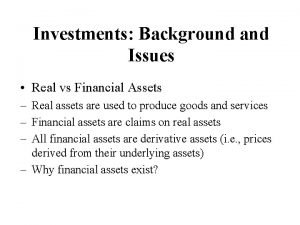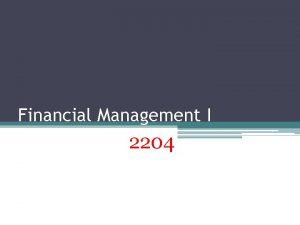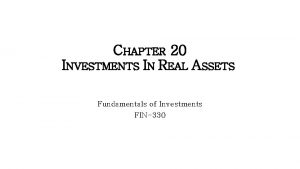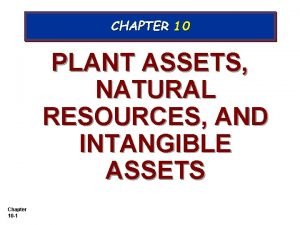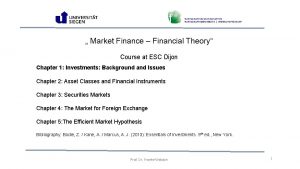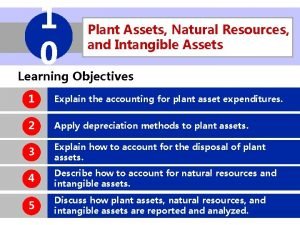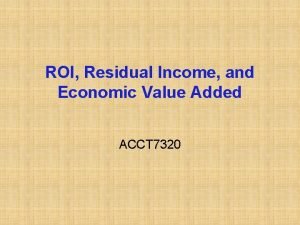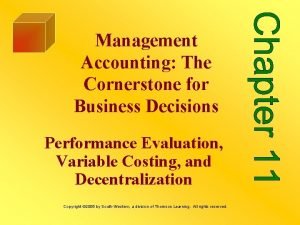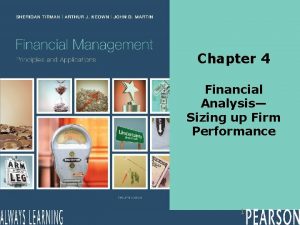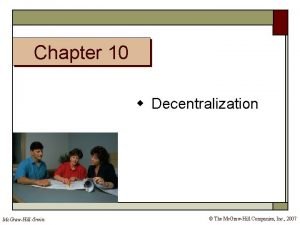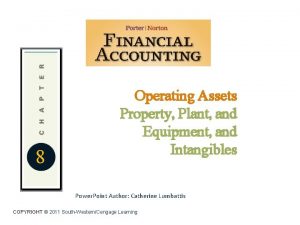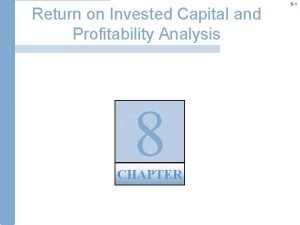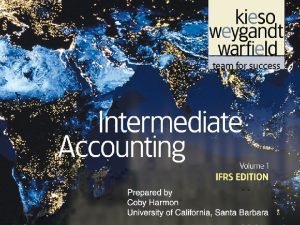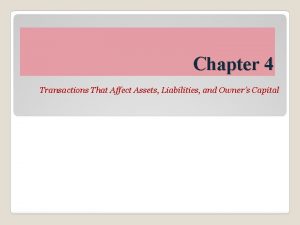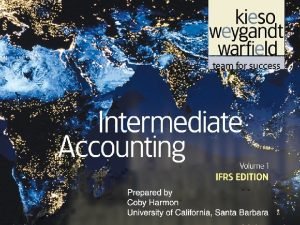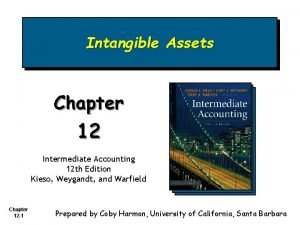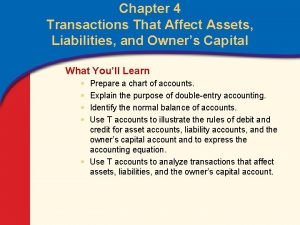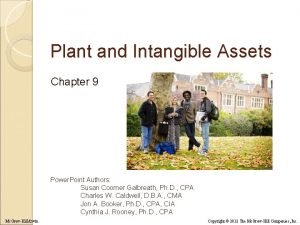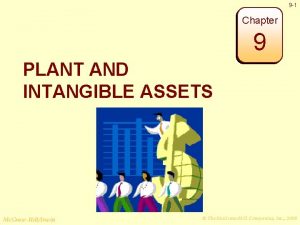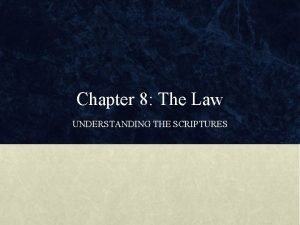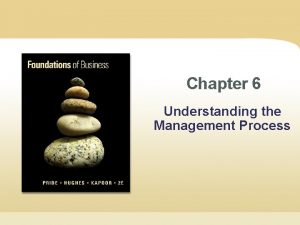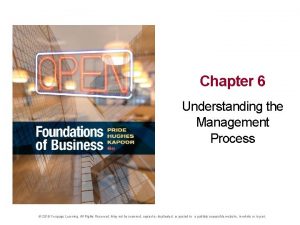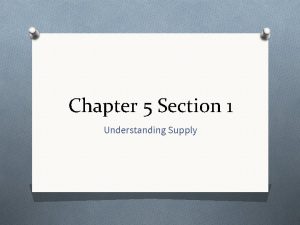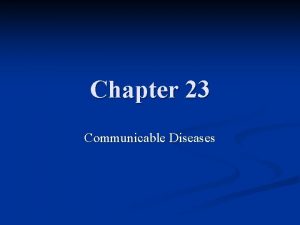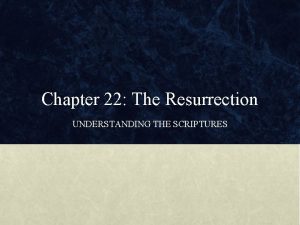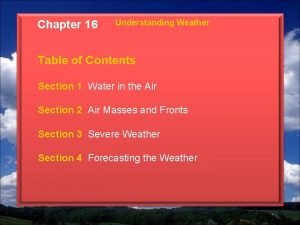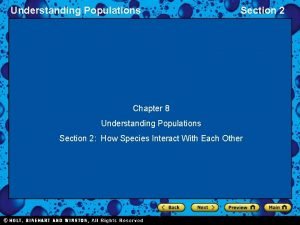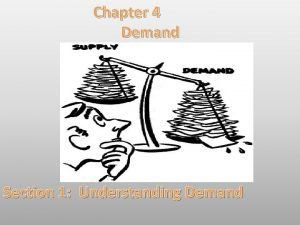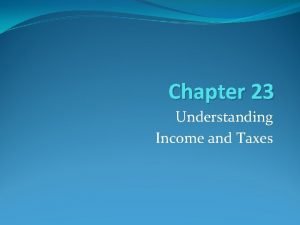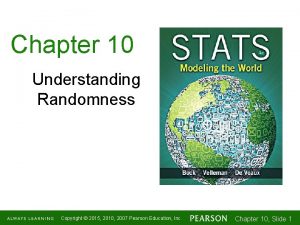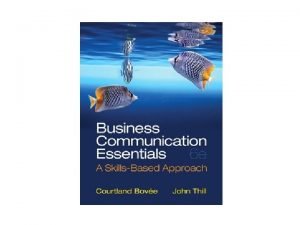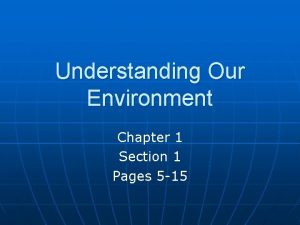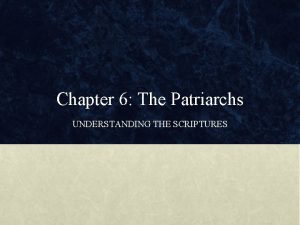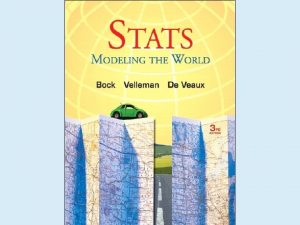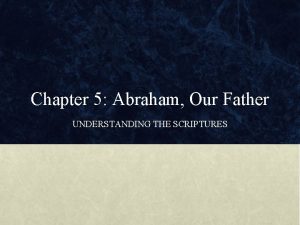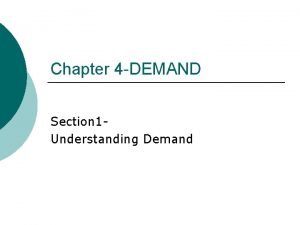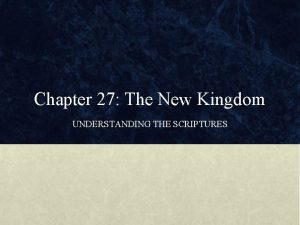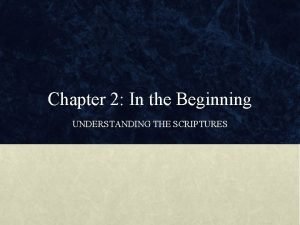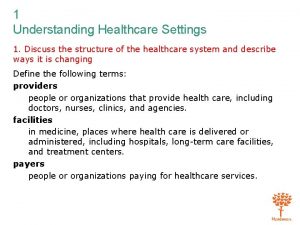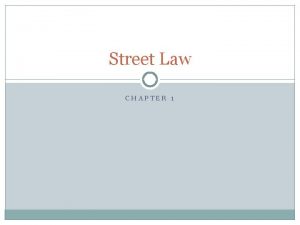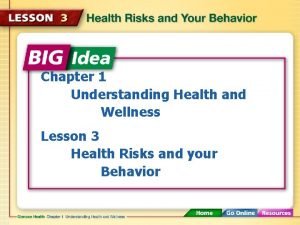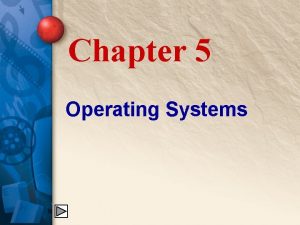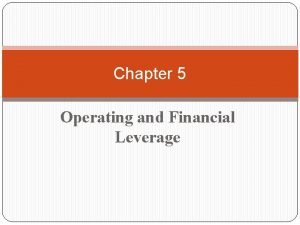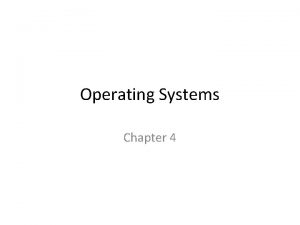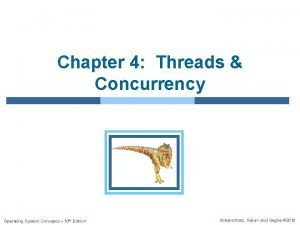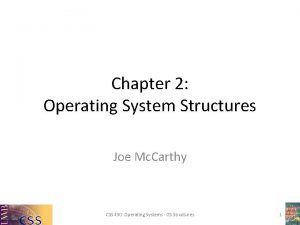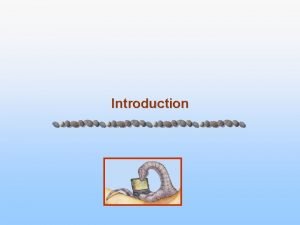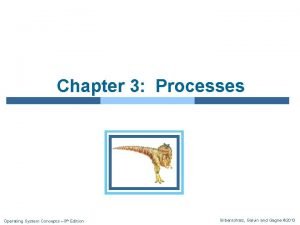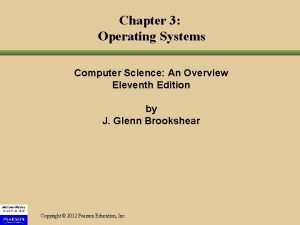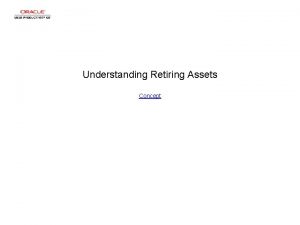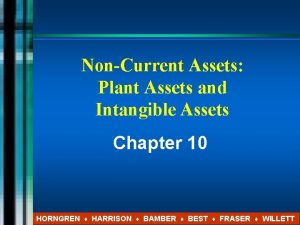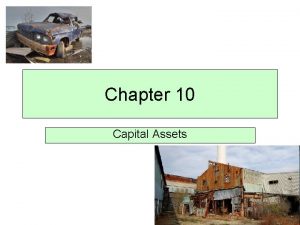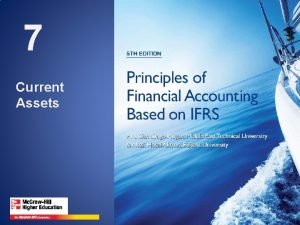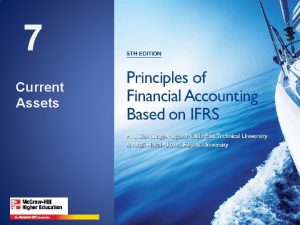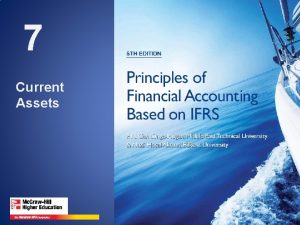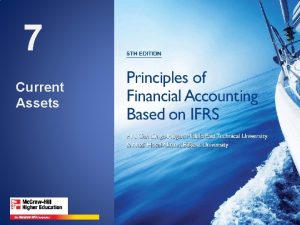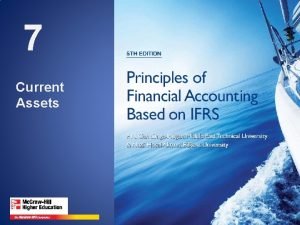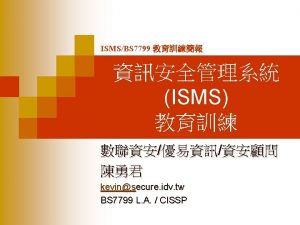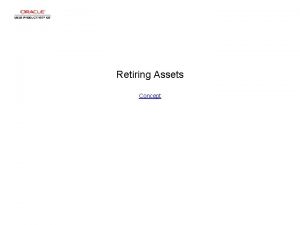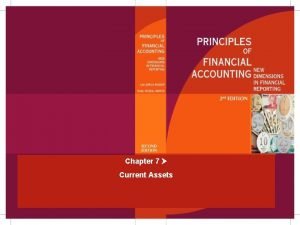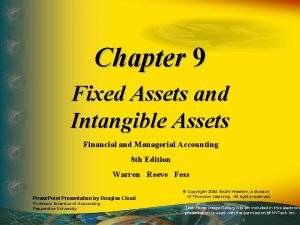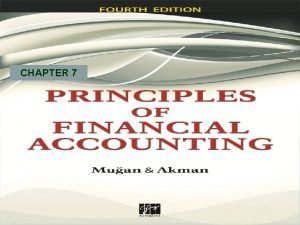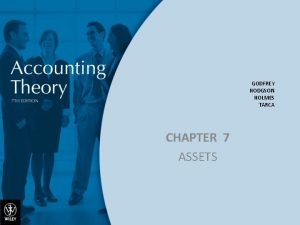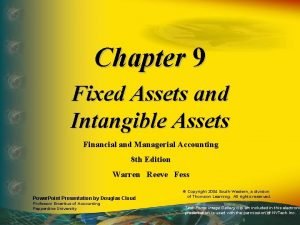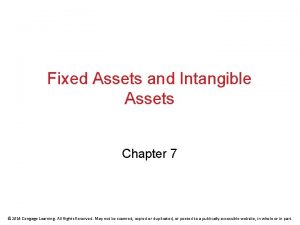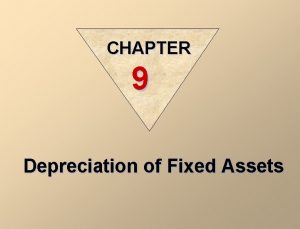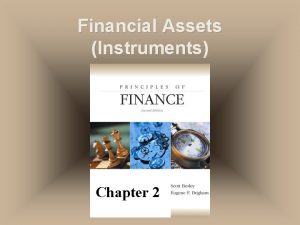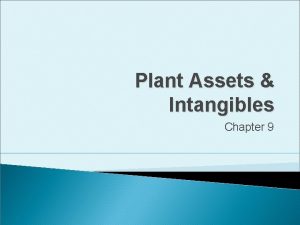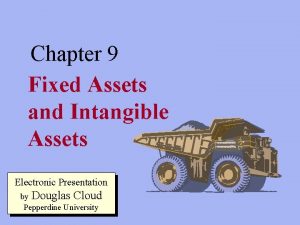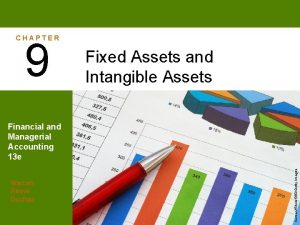Chapter 7 Operating Assets Understanding Operating Assets Operating






































































- Slides: 70

Chapter 7 Operating Assets

Understanding Operating Assets § Operating assets are the long-lived assets that are used by the company in the normal course of operations. § Unlike inventory, operating assets are not sold to customers. § Instead, operating assets are used by a company in the normal course of operations to generate revenue. LO-1 © 2014 Cengage Learning. All Rights Reserved. May not be copied, scanned, or duplicated, in whole or in part, except for use as permitted in a license distributed with a certain product or service or otherwise on a password-protected website for classroom use.

Understanding Operating Assets § Operating assets are divided into three categories: § Property, plant, and equipment are often called fixed assets or plant assets. They include land, buildings, machines, and automobiles. § Intangible assets do not have physical substance. They include patents, copyrights, trademarks, licenses, and goodwill. § Natural resources are naturally occurring materials. They include timberlands and deposits such as coal, oil, and gravel. LO-1 © 2014 Cengage Learning. All Rights Reserved. May not be copied, scanned, or duplicated, in whole or in part, except for use as permitted in a license distributed with a certain product or service or otherwise on a password-protected website for classroom use.

Understanding Operating Assets § Operating assets represent future economic benefits, or service potential, that will be used in the normal course of operations. § At acquisition, an operating asset is recorded at its cost, including the cost of acquiring the asset and the cost of preparing the asset for use (historical cost principle). These costs are said to be capitalized. LO-1 © 2014 Cengage Learning. All Rights Reserved. May not be copied, scanned, or duplicated, in whole or in part, except for use as permitted in a license distributed with a certain product or service or otherwise on a password-protected website for classroom use.

Understanding Operating Assets § As the service potential of an operating asset declines, the cost of the asset is allocated as an expense among the accounting periods in which the asset is used and benefits are received (the matching principle). § This allocation is called depreciation for property, plant, and equipment assets, amortization for intangible assets, and depletion for natural resources. LO-1 © 2014 Cengage Learning. All Rights Reserved. May not be copied, scanned, or duplicated, in whole or in part, except for use as permitted in a license distributed with a certain product or service or otherwise on a password-protected website for classroom use.

Acquisition of Property, Plant, and Equipment § Property, plant, and equipment are the tangible operating assets and include: § Land: The site of a manufacturing facility or office building used in operations § Land Improvements: Structural additions or improvements to land (such as driveways, parking lots, fences, landscaping, lighting) LO-2 © 2014 Cengage Learning. All Rights Reserved. May not be copied, scanned, or duplicated, in whole or in part, except for use as permitted in a license distributed with a certain product or service or otherwise on a password-protected website for classroom use.

Acquisition of Property, Plant, and Equipment § Buildings: Structures used in operations (factory, office, warehouse) § Equipment: Assets used in operations (machinery, furniture, automobiles) § It is important to note that land, unlike other assets, has an unlimited life and service potential and is not subject to depreciation. LO-2 © 2014 Cengage Learning. All Rights Reserved. May not be copied, scanned, or duplicated, in whole or in part, except for use as permitted in a license distributed with a certain product or service or otherwise on a password-protected website for classroom use.

Measuring the Cost of a Fixed Asset § The cost of a fixed asset is an expenditure necessary to acquire the asset and to prepare the asset for use. § Expenditures that are included as part of the cost of the asset are said to be capitalized. § Expenditures that are not included as part of the cost of the asset are expensed immediately. § Careful judgment should be exercised in determining which costs should be capitalized and which costs should be expensed. LO-2 © 2014 Cengage Learning. All Rights Reserved. May not be copied, scanned, or duplicated, in whole or in part, except for use as permitted in a license distributed with a certain product or service or otherwise on a password-protected website for classroom use.

Typical Costs of Acquiring Property, Plant, and Equipment LO-2 © 2014 Cengage Learning. All Rights Reserved. May not be copied, scanned, or duplicated, in whole or in part, except for use as permitted in a license distributed with a certain product or service or otherwise on a password-protected website for classroom use.

Recording the Cost of a Fixed Asset § The historical cost principle requires that a company record its fixed assets at the exchange price at the time the asset is purchased. § When cash is paid in exchange for an asset, the amount of cash given, plus any other expenditure necessary to prepare the asset for use, becomes part of the historical cost of the acquired asset. LO-2 © 2014 Cengage Learning. All Rights Reserved. May not be copied, scanned, or duplicated, in whole or in part, except for use as permitted in a license distributed with a certain product or service or otherwise on a password-protected website for classroom use.

Recording the Cost of a Fixed Asset § Fixed assets can also be purchased by issuing debt. In this situation, the asset is valued at the fair value of the liability on the date the asset is acquired. § When noncash consideration, such as land or other noncash assets, is given in exchange for an asset, the purchase price of the acquired asset is the fair value of the asset given up or the fair value of the asset received, whichever is more clearly determinable. LO-2 © 2014 Cengage Learning. All Rights Reserved. May not be copied, scanned, or duplicated, in whole or in part, except for use as permitted in a license distributed with a certain product or service or otherwise on a password-protected website for classroom use.

Cornerstone 7. 1 Measuring and Recording the Cost of a Fixed Asset LO-2 © 2014 Cengage Learning. All Rights Reserved. May not be copied, scanned, or duplicated, in whole or in part, except for use as permitted in a license distributed with a certain product or service or otherwise on a password-protected website for classroom use.

Depreciation § Depreciation is the process of allocating, in a systematic and rational manner, the cost of a tangible fixed asset (other than land) to expense over the asset’s useful life. § The matching principle provides the conceptual basis for measuring and recognizing depreciation and requires that the cost of a fixed asset be allocated as an expense among the accounting periods in which the asset is used and revenues are generated by its use. LO-3 © 2014 Cengage Learning. All Rights Reserved. May not be copied, scanned, or duplicated, in whole or in part, except for use as permitted in a license distributed with a certain product or service or otherwise on a password-protected website for classroom use.

Depreciation § The amount of depreciation recorded each period, or depreciation expense, is reported on the income statement. § Accumulated depreciation, which represents the total amount of depreciation expense that has been recorded for an asset since the asset was acquired, is reported on the balance sheet as a contra-asset. § Accumulated depreciation is deducted from the cost of the asset to get the asset’s book value (or carrying value). LO-3 © 2014 Cengage Learning. All Rights Reserved. May not be copied, scanned, or duplicated, in whole or in part, except for use as permitted in a license distributed with a certain product or service or otherwise on a password-protected website for classroom use.

Information Required for Measuring Depreciation § The following information is necessary in order to measure depreciation: § cost of the fixed asset § useful life (or expected life) of the fixed asset § Residual value (salvage value) of the fixed asset § Cost of the fixed asset is any expenditure necessary to acquire the asset and to prepare the asset for use. LO-3 © 2014 Cengage Learning. All Rights Reserved. May not be copied, scanned, or duplicated, in whole or in part, except for use as permitted in a license distributed with a certain product or service or otherwise on a password-protected website for classroom use.

Information Required for Measuring Depreciation § The useful life of an asset is the period of time over which the company anticipates deriving benefit from the use of the asset. § The residual value (also called salvage value) is the amount of cash or trade-in consideration that the company expects to receive when an asset is retired from service. § The cost of an asset minus its residual value gives an asset’s depreciable cost. LO-3 © 2014 Cengage Learning. All Rights Reserved. May not be copied, scanned, or duplicated, in whole or in part, except for use as permitted in a license distributed with a certain product or service or otherwise on a password-protected website for classroom use.

Depreciation Methods § The service potential of a fixed asset is assumed to decline with each period of use, but the pattern of decline is not the same for all assets. As a result, various depreciation methods exist. § Depreciation methods are standardized calculations required to determine periodic depreciation expense. § The most common depreciation methods are: § straight-line § declining balance § units-of-production LO-4 © 2014 Cengage Learning. All Rights Reserved. May not be copied, scanned, or duplicated, in whole or in part, except for use as permitted in a license distributed with a certain product or service or otherwise on a password-protected website for classroom use.

Depreciation Methods LO-4 © 2014 Cengage Learning. All Rights Reserved. May not be copied, scanned, or duplicated, in whole or in part, except for use as permitted in a license distributed with a certain product or service or otherwise on a password-protected website for classroom use.

Straight-Line Method § Straight-line depreciation method allocates an equal amount of an asset’s cost to depreciation expense for each year of the asset’s useful life. § It is appropriate to apply this method to those assets for which an equal amount of service potential is considered to be used each period. § It is most used because it is simple to apply and is based on a pattern of service potential decline that is reasonable for many fixed assets. LO-4 © 2014 Cengage Learning. All Rights Reserved. May not be copied, scanned, or duplicated, in whole or in part, except for use as permitted in a license distributed with a certain product or service or otherwise on a password-protected website for classroom use.

Straight-Line Method Calculation § The computation of straight-line depreciation expense is based on an asset’s depreciable cost. § Straight-line depreciation expense for each period is calculated by dividing the depreciable cost of an asset by the asset’s useful life as follows: Straight-Line Depreciation = (Cost – Residual Value) / Expected Useful Life LO-4 © 2014 Cengage Learning. All Rights Reserved. May not be copied, scanned, or duplicated, in whole or in part, except for use as permitted in a license distributed with a certain product or service or otherwise on a password-protected website for classroom use.

Cornerstone 7. 2 Computing Depreciation Expense Using the Straight-Line Method LO-4 © 2014 Cengage Learning. All Rights Reserved. May not be copied, scanned, or duplicated, in whole or in part, except for use as permitted in a license distributed with a certain product or service or otherwise on a password-protected website for classroom use.

Cornerstone 7. 2 Computing Depreciation Expense Using the Straight-Line Method LO-4 © 2014 Cengage Learning. All Rights Reserved. May not be copied, scanned, or duplicated, in whole or in part, except for use as permitted in a license distributed with a certain product or service or otherwise on a password-protected website for classroom use.

Declining Balance Method § The declining balance depreciation method is an accelerated depreciation method that produces a declining amount of depreciation expense each period by multiplying the declining book value of an asset by a constant depreciation rate. § It results in a larger amount of depreciation expense in the early years of an asset’s life relative to the straight-line method. LO-4 © 2014 Cengage Learning. All Rights Reserved. May not be copied, scanned, or duplicated, in whole or in part, except for use as permitted in a license distributed with a certain product or service or otherwise on a password-protected website for classroom use.

Declining Balance Method § The declining balance depreciation rate is some multiple (m) times the straight-line rate: Declining Balance Rate = (m) x Straight-Line Rate LO-4 © 2014 Cengage Learning. All Rights Reserved. May not be copied, scanned, or duplicated, in whole or in part, except for use as permitted in a license distributed with a certain product or service or otherwise on a password-protected website for classroom use.

Declining Balance Method § Depreciation expense for each period of an asset’s useful life equals the declining balance rate times the asset’s book value (cost less accumulated depreciation) at the beginning of the period as shown: Declining Balance Depreciation Expense = Declining Balance Rate x Book Value LO-4 © 2014 Cengage Learning. All Rights Reserved. May not be copied, scanned, or duplicated, in whole or in part, except for use as permitted in a license distributed with a certain product or service or otherwise on a password-protected website for classroom use.

Cornerstone 7. 3 Computing Depreciation Expense Using the Declining Balance Method LO-4 © 2014 Cengage Learning. All Rights Reserved. May not be copied, scanned, or duplicated, in whole or in part, except for use as permitted in a license distributed with a certain product or service or otherwise on a password-protected website for classroom use.

Cornerstone 7. 3 Computing Depreciation Expense Using the Declining Balance Method LO-4 © 2014 Cengage Learning. All Rights Reserved. May not be copied, scanned, or duplicated, in whole or in part, except for use as permitted in a license distributed with a certain product or service or otherwise on a password-protected website for classroom use.

Difference between Straight-Line and Declining Balance Method § The calculation of declining balance depreciation expense differs from the calculation of straightline depreciation expense in two important ways: § The straight-line method multiplies a depreciation rate by the depreciable cost of the asset. However, the declining balance method multiplies a depreciation rate by the book value of the asset. Because the book value declines as depreciation expense is recorded, this produces a declining pattern of depreciation expense over time. LO-4 © 2014 Cengage Learning. All Rights Reserved. May not be copied, scanned, or duplicated, in whole or in part, except for use as permitted in a license distributed with a certain product or service or otherwise on a password-protected website for classroom use.

Difference between Straight-Line and Declining Balance Method § The straight-line method records an equal amount of depreciation expense each period of the asset’s life. It is likely that the computation of depreciation expense under the declining balance method would cause the asset’s book value to fall below its residual value. Typically, a lower amount of depreciation expense (relative to what is calculated under the declining balance method) must be recorded in the last year of the asset’s life so that depreciation stops once the residual value is reached. LO-4 © 2014 Cengage Learning. All Rights Reserved. May not be copied, scanned, or duplicated, in whole or in part, except for use as permitted in a license distributed with a certain product or service or otherwise on a password-protected website for classroom use.

Units-of-Production Method § When the decline in an asset’s service potential is proportional to the usage of the asset and asset usage can be measured, depreciation expense can be computed using the units-of-production method. § Usage is typically gauged by a measure of productive capacity. LO-4 © 2014 Cengage Learning. All Rights Reserved. May not be copied, scanned, or duplicated, in whole or in part, except for use as permitted in a license distributed with a certain product or service or otherwise on a password-protected website for classroom use.

Units-of-Production Method § To compute depreciation expense under the units -of-production method, the depreciation cost per unit is determined as shown in the following equation: Depreciation Cost per Unit = (Cost – Residual Value) / Expected Usage of the Asset LO-4 © 2014 Cengage Learning. All Rights Reserved. May not be copied, scanned, or duplicated, in whole or in part, except for use as permitted in a license distributed with a certain product or service or otherwise on a password-protected website for classroom use.

Units-of-Production Method § Next, the depreciation cost per unit is multiplied by the actual usage of the asset: Units-of-Production Depreciation Expense = Depreciation Cost per Unit x Actual Usage of the Asset LO-4 © 2014 Cengage Learning. All Rights Reserved. May not be copied, scanned, or duplicated, in whole or in part, except for use as permitted in a license distributed with a certain product or service or otherwise on a password-protected website for classroom use.

Cornerstone 7. 4 Computing Depreciation Expense Using the Units-of-Production Method LO-4 © 2014 Cengage Learning. All Rights Reserved. May not be copied, scanned, or duplicated, in whole or in part, except for use as permitted in a license distributed with a certain product or service or otherwise on a password-protected website for classroom use.

Cornerstone 7. 4 Computing Depreciation Expense Using the Units-of-Production Method LO-4 © 2014 Cengage Learning. All Rights Reserved. May not be copied, scanned, or duplicated, in whole or in part, except for use as permitted in a license distributed with a certain product or service or otherwise on a password-protected website for classroom use.

Choosing Between Depreciation Methods § The three depreciation methods can be summarized as follows: § The straight-line depreciation method produces a constant amount of depreciation expense in each period of the asset’s life and is consistent with a constant rate of decline in service potential. LO-4 © 2014 Cengage Learning. All Rights Reserved. May not be copied, scanned, or duplicated, in whole or in part, except for use as permitted in a license distributed with a certain product or service or otherwise on a password-protected website for classroom use.

Choosing Between Depreciation Methods § The declining balance depreciation method accelerates the assignment of an asset’s cost to depreciation expense by allocating a larger amount of cost to the early years of an asset’s life. This is consistent with a decreasing rate of decline in service potential and a decreasing amount for depreciation expense. § The units-of-production depreciation method is based on a measure of the asset’s use in each period, and the periodic depreciation expense rises and falls with the asset’s use. In this sense, the units-of-production depreciation method is based not on a standardized pattern of declining service potential but on a pattern tailored to the individual asset and its use. LO-4 © 2014 Cengage Learning. All Rights Reserved. May not be copied, scanned, or duplicated, in whole or in part, except for use as permitted in a license distributed with a certain product or service or otherwise on a password-protected website for classroom use.

Depreciation for Partial Years § Fixed assets are purchased (or disposed of) at various times throughout the year. § If the fixed asset is purchased (or disposed of) at the beginning or end of an accounting period, a full year of depreciation is recorded. § If, however, the asset is purchased (or disposed of) during the accounting period, the matching principle requires that depreciation be recorded only for the portion of the year that the asset was used to generate revenue. LO-4 © 2014 Cengage Learning. All Rights Reserved. May not be copied, scanned, or duplicated, in whole or in part, except for use as permitted in a license distributed with a certain product or service or otherwise on a password-protected website for classroom use.

Expenditures after Acquisition § In addition to expenditures made when property, plant, and equipment is purchased, companies incur costs over the life of the asset that range from ordinary repairs and maintenance to major overhauls, additions, and improvements. § Companies must decide whether these expenditures should be capitalized (added to an asset account) or expensed (reported in total on the income statement). LO-5 © 2014 Cengage Learning. All Rights Reserved. May not be copied, scanned, or duplicated, in whole or in part, except for use as permitted in a license distributed with a certain product or service or otherwise on a password-protected website for classroom use.

Revenue Expenditures § Expenditures that do not increase the future economic benefits of the asset are called revenue expenditures and are expensed in the same period the expenditure is made. § These expenditures maintain the level of benefits provided by the asset, relate only to the current period, occur frequently, and typically involve relatively small dollar amounts. § An example of a revenue expenditure is the ordinary repair and maintenance of an asset. LO-5 © 2014 Cengage Learning. All Rights Reserved. May not be copied, scanned, or duplicated, in whole or in part, except for use as permitted in a license distributed with a certain product or service or otherwise on a password-protected website for classroom use.

Capital Expenditures § Expenditures that extend the life of the asset, expand the productive capacity, increase efficiency, or improve the quality of the product, are called capital expenditures. § Because these expenditures provide benefits to the company in both current and future periods, capital expenditures are added to an asset account and are subject to depreciation LO-5 © 2014 Cengage Learning. All Rights Reserved. May not be copied, scanned, or duplicated, in whole or in part, except for use as permitted in a license distributed with a certain product or service or otherwise on a password-protected website for classroom use.

Capital Expenditures § These expenditures typically involve relatively large dollar amounts. § Examples of capital expenditures include extraordinary or major repairs, additions, remodeling of buildings, and improvements (sometimes called betterments). LO-5 © 2014 Cengage Learning. All Rights Reserved. May not be copied, scanned, or duplicated, in whole or in part, except for use as permitted in a license distributed with a certain product or service or otherwise on a password-protected website for classroom use.

Types of Expenditures LO-5 © 2014 Cengage Learning. All Rights Reserved. May not be copied, scanned, or duplicated, in whole or in part, except for use as permitted in a license distributed with a certain product or service or otherwise on a password-protected website for classroom use.

Revision of Depreciation § Depreciation expense is based on estimates of useful life and residual value. § As new or additional information becomes available, a company will often find it necessary to revise its estimates of useful life, residual value, or both. § To revise depreciation expense, the following steps are performed: § Step 1: Obtain the book value of the asset at the date of the revision of depreciation. § Step 2: Compute depreciation expense using the revised amounts for book value, useful life, and/or residual value. LO-6 © 2014 Cengage Learning. All Rights Reserved. May not be copied, scanned, or duplicated, in whole or in part, except for use as permitted in a license distributed with a certain product or service or otherwise on a password-protected website for classroom use.

Cornerstone 7. 5 Revising Depreciation Expense LO-6 © 2014 Cengage Learning. All Rights Reserved. May not be copied, scanned, or duplicated, in whole or in part, except for use as permitted in a license distributed with a certain product or service or otherwise on a password-protected website for classroom use.

Impairments § Because depreciation is a cost allocation process and does not attempt to measure the fair value of the asset, the book value of an asset and the fair value of an asset may be quite different. § When the fair value of the asset falls significantly below the book value of the asset, the asset may be impaired. § An impairment is a permanent decline in the future benefit or service potential of an asset. § The impairment may be due to numerous factors, including too little depreciation expense being recorded in previous years or obsolescence of the asset. LO-6 © 2014 Cengage Learning. All Rights Reserved. May not be copied, scanned, or duplicated, in whole or in part, except for use as permitted in a license distributed with a certain product or service or otherwise on a password-protected website for classroom use.

Appendix 7 A: Impairment of Property, Plant and Equipment § An impairment is a permanent decline in the future benefit or service potential of an asset. § Impairment may be due to numerous factors, including too little depreciation expense being recorded in previous years or obsolescence of the asset. § A company is required to review an asset for impairment if events or circumstances lead the company to believe that an asset may be impaired LO-11 © 2014 Cengage Learning. All Rights Reserved. May not be copied, scanned, or duplicated, in whole or in part, except for use as permitted in a license distributed with a certain product or service or otherwise on a password-protected website for classroom use.

Appendix 7 A: Impairment of Property, Plant and Equipment § Consistent with the principle of conservatism, if a fixed asset is impaired, a company should reduce the asset’s book value to its fair value in the year the impairment occurs. LO-11 © 2014 Cengage Learning. All Rights Reserved. May not be copied, scanned, or duplicated, in whole or in part, except for use as permitted in a license distributed with a certain product or service or otherwise on a password-protected website for classroom use.

Appendix 7 A: Two Step Impairment Test § The impairment test consists of two steps: § Step 1. Existence: An impairment exists if the future cash flows expected to be generated by the asset are less than the asset’s book value. § Step 2. Measurement: If an impairment exists, the impairment loss is measured as the difference between the book value and the fair value of the asset. LO-11 © 2014 Cengage Learning. All Rights Reserved. May not be copied, scanned, or duplicated, in whole or in part, except for use as permitted in a license distributed with a certain product or service or otherwise on a password-protected website for classroom use.

Cornerstone 7. 10 Recording an Impairment of Property, Plant, and Equipment © 2014 Cengage Learning. All Rights Reserved. May not be copied, scanned, or duplicated, in whole or in part, except for use as permitted in a license distributed with a certain product or service or otherwise on a password-protected website for classroom use.

Disposal of Fixed Assets § Although companies usually dispose of fixed assets voluntarily, disposition may also be forced. § Voluntary disposal occurs when the company determines that the asset is no longer useful. The disposal may occur at the end of the asset’s useful life or at some other time. For example, obsolescence due to unforeseen technological developments may lead to an earlier than expected disposition of the asset. § Involuntary disposal occurs when assets are lost or destroyed through theft, acts of nature, or by accident. LO-7 © 2014 Cengage Learning. All Rights Reserved. May not be copied, scanned, or duplicated, in whole or in part, except for use as permitted in a license distributed with a certain product or service or otherwise on a password-protected website for classroom use.

Disposal of Fixed Assets § Two journal entries are required for disposals of fixed assets: § An entry to record depreciation expense up to the date of disposal. § An entry to: § Remove the asset’s book value (the cost of the asset and the related accumulated depreciation). § Record a gain or loss on disposal of the asset, which is computed as the difference between the proceeds from the sale and the book value of the asset. LO-7 © 2014 Cengage Learning. All Rights Reserved. May not be copied, scanned, or duplicated, in whole or in part, except for use as permitted in a license distributed with a certain product or service or otherwise on a password-protected website for classroom use.

Cornerstone 7. 6 Recording the Disposition of Property, Plant and Equipment LO-7 © 2014 Cengage Learning. All Rights Reserved. May not be copied, scanned, or duplicated, in whole or in part, except for use as permitted in a license distributed with a certain product or service or otherwise on a password-protected website for classroom use.

Cornerstone 7. 6 Recording the Disposition of Property, Plant and Equipment LO-7 © 2014 Cengage Learning. All Rights Reserved. May not be copied, scanned, or duplicated, in whole or in part, except for use as permitted in a license distributed with a certain product or service or otherwise on a password-protected website for classroom use.

Analyzing Fixed Assets § It is important to understand how efficiently a company is using its fixed assets because fixed assets are the productive assets. § One measure of efficiency in the use of fixed assets is the fixed asset turnover ratio. It is calculated as: Fixed Asset Turnover Ratio = Net Sales ÷ Average Fixed Assets LO-8 © 2014 Cengage Learning. All Rights Reserved. May not be copied, scanned, or duplicated, in whole or in part, except for use as permitted in a license distributed with a certain product or service or otherwise on a password-protected website for classroom use.

Analyzing Fixed Assets § (The more efficiently a company uses its fixed assets, the higher the ratio will be. ) § Investors are also concerned with the condition of a company’s fixed assets. Typically, older assets tend to be less efficient. § A rough estimate of the average of fixed assets can be computed as follows: Average Age of Fixed Assets = Accumulated Depreciation ÷ Depreciation Expense LO-8 © 2014 Cengage Learning. All Rights Reserved. May not be copied, scanned, or duplicated, in whole or in part, except for use as permitted in a license distributed with a certain product or service or otherwise on a password-protected website for classroom use.

Cornerstone 7. 7 Analyzing Fixed Asset Ratios LO-8 © 2014 Cengage Learning. All Rights Reserved. May not be copied, scanned, or duplicated, in whole or in part, except for use as permitted in a license distributed with a certain product or service or otherwise on a password-protected website for classroom use.

Cornerstone 7. 7 Analyzing Fixed Asset Ratios LO-8 © 2014 Cengage Learning. All Rights Reserved. May not be copied, scanned, or duplicated, in whole or in part, except for use as permitted in a license distributed with a certain product or service or otherwise on a password-protected website for classroom use.

Intangible Assets § Intangible operating assets, like tangible assets, represent future economic benefit to the company, but unlike tangible assets, they lack physical substance. § Patents, copyrights, trademarks, leaseholds, organization costs, franchises, and goodwill are all examples of intangible assets. LO-9 © 2014 Cengage Learning. All Rights Reserved. May not be copied, scanned, or duplicated, in whole or in part, except for use as permitted in a license distributed with a certain product or service or otherwise on a password-protected website for classroom use.

Intangible Assets § The economic benefits associated with most intangible assets are in the form of legal rights and privileges conferred on the owner of the asset. § The economic value of a patent, for example, is the legal right to restrict, control, or charge for the use of the idea or process covered by the patent. LO-9 © 2014 Cengage Learning. All Rights Reserved. May not be copied, scanned, or duplicated, in whole or in part, except for use as permitted in a license distributed with a certain product or service or otherwise on a password-protected website for classroom use.

Accounting for Intangible Assets § Intangible assets are recorded at cost, consistent with the historical cost principle. The cost of an intangible asset is any expenditure necessary to acquire the asset and to prepare the asset for use. § For intangible assets purchased from outside the company, the primary element of the cost is the purchase price. For internally developed intangible assets, the cost of developing the asset is expensed as incurred and normally recorded as research and development (R&D) expense LO-9 © 2014 Cengage Learning. All Rights Reserved. May not be copied, scanned, or duplicated, in whole or in part, except for use as permitted in a license distributed with a certain product or service or otherwise on a password-protected website for classroom use.

Accounting for Intangible Assets § The cost of an intangible asset with a finite life, is allocated to accounting periods over the life of the asset to reflect the decline in service potential. This process is referred to as amortization. If intangibles have indefinite lives, they are instead reviewed at least annually for impairment. LO-9 © 2014 Cengage Learning. All Rights Reserved. May not be copied, scanned, or duplicated, in whole or in part, except for use as permitted in a license distributed with a certain product or service or otherwise on a password-protected website for classroom use.

Common Types of Intangible Assets LO-9 © 2014 Cengage Learning. All Rights Reserved. May not be copied, scanned, or duplicated, in whole or in part, except for use as permitted in a license distributed with a certain product or service or otherwise on a password-protected website for classroom use.

Cornerstone 7. 8 Accounting for Intangible Assets LO-9 © 2014 Cengage Learning. All Rights Reserved. May not be copied, scanned, or duplicated, in whole or in part, except for use as permitted in a license distributed with a certain product or service or otherwise on a password-protected website for classroom use.

Cornerstone 7. 8 Accounting for Intangible Assets LO-9 © 2014 Cengage Learning. All Rights Reserved. May not be copied, scanned, or duplicated, in whole or in part, except for use as permitted in a license distributed with a certain product or service or otherwise on a password-protected website for classroom use.

Natural Resources § Natural resources, such as coal deposits, oil reserves, and mineral deposits, make up an important part of the operating assets for many companies. § Like intangible assets, natural resources present difficult estimation and measurement problems. LO-10 © 2014 Cengage Learning. All Rights Reserved. May not be copied, scanned, or duplicated, in whole or in part, except for use as permitted in a license distributed with a certain product or service or otherwise on a password-protected website for classroom use.

Natural Resources § However, natural resources differ from other operating assets in two important ways: § Unlike fixed assets, natural resources are physically consumed as they are used by a company. § Natural resources can generally be replaced or restored only by an act of nature. (Timberlands are renewed by replanting and growth, but coal deposits and most mineral deposits are not subject to renewal. ) LO-10 © 2014 Cengage Learning. All Rights Reserved. May not be copied, scanned, or duplicated, in whole or in part, except for use as permitted in a license distributed with a certain product or service or otherwise on a password-protected website for classroom use.

Depletion § As a natural resource is removed from the earth, the cost of the natural resource is allocated to each unit of natural resource removed. This process of allocating the cost of the natural resource to each period in which the resource is used is called depletion. § Depletion is computed by using a procedure similar to that for the units-of-production method of depreciation. LO-10 © 2014 Cengage Learning. All Rights Reserved. May not be copied, scanned, or duplicated, in whole or in part, except for use as permitted in a license distributed with a certain product or service or otherwise on a password-protected website for classroom use.

Depletion § First, a depletion rate is computed as follows: Depletion Rate = Cost – Residual Value / Recoverable Units § Second, depletion is calculated by multiplying the depletion rate by the number of units of the natural resource recovered during the period: Depletion = Depletion Rate x Units Recovered LO-10 © 2014 Cengage Learning. All Rights Reserved. May not be copied, scanned, or duplicated, in whole or in part, except for use as permitted in a license distributed with a certain product or service or otherwise on a password-protected website for classroom use.

Cornerstone 7. 9 Accounting for Depletion of a Natural Resource LO-10 © 2014 Cengage Learning. All Rights Reserved. May not be copied, scanned, or duplicated, in whole or in part, except for use as permitted in a license distributed with a certain product or service or otherwise on a password-protected website for classroom use.

Cornerstone 7. 9 Accounting for Depletion of a Natural Resource LO-10 © 2014 Cengage Learning. All Rights Reserved. May not be copied, scanned, or duplicated, in whole or in part, except for use as permitted in a license distributed with a certain product or service or otherwise on a password-protected website for classroom use.
 Financial assets and real assets
Financial assets and real assets Real assets vs financial assets
Real assets vs financial assets Real assets definition
Real assets definition Plant assets natural resources and intangible assets
Plant assets natural resources and intangible assets Plant assets natural resources and intangible assets
Plant assets natural resources and intangible assets Real assets versus financial assets
Real assets versus financial assets Plant assets, natural resources, and intangible assets
Plant assets, natural resources, and intangible assets How to find average operating assets
How to find average operating assets How to calculate eva
How to calculate eva Asset turnover ratio formula
Asset turnover ratio formula Average operating assets formula
Average operating assets formula Operating assets examples
Operating assets examples Noa turnover
Noa turnover Operating system history
Operating system history Examples of intangible assets
Examples of intangible assets Chapter 4 review transactions that affect assets
Chapter 4 review transactions that affect assets Chapter 12 intangible assets
Chapter 12 intangible assets Intangible examples
Intangible examples Capital=assets+liabilities
Capital=assets+liabilities Plant and intangible assets chapter 9
Plant and intangible assets chapter 9 Plant and intangible assets chapter 9
Plant and intangible assets chapter 9 Chapter 9 lesson 3 understanding violence
Chapter 9 lesson 3 understanding violence Understanding the scriptures chapter 24 study questions
Understanding the scriptures chapter 24 study questions Chapter 6 understanding the management process
Chapter 6 understanding the management process The process of evaluating and regulating ongoing activities
The process of evaluating and regulating ongoing activities Understanding supply section 1
Understanding supply section 1 Chapter 23 communicable diseases
Chapter 23 communicable diseases Understanding the scriptures chapter 22 study questions
Understanding the scriptures chapter 22 study questions Understanding the scriptures chapter 20 study questions
Understanding the scriptures chapter 20 study questions Chapter 16 understanding weather answer key
Chapter 16 understanding weather answer key Chapter 8 understanding populations
Chapter 8 understanding populations Chapter 4 lesson 1 understanding stress
Chapter 4 lesson 1 understanding stress Chapter 4 section 1 understanding demand
Chapter 4 section 1 understanding demand Chapter 23 understanding income and taxes
Chapter 23 understanding income and taxes Ap stats chapter 10 understanding randomness
Ap stats chapter 10 understanding randomness Understanding your health and wellness chapter 1
Understanding your health and wellness chapter 1 Chapter 1 health and wellness fundamentals
Chapter 1 health and wellness fundamentals Chapter 1 understanding your health and wellness
Chapter 1 understanding your health and wellness Understanding human communication 14th edition chapter 1
Understanding human communication 14th edition chapter 1 Chapter 1 lesson 4 promoting health and wellness
Chapter 1 lesson 4 promoting health and wellness Chapter 1 lesson 2 what affects your health
Chapter 1 lesson 2 what affects your health Chapter 1 lesson 2 what affects your health
Chapter 1 lesson 2 what affects your health Chapter 1 understanding health and wellness
Chapter 1 understanding health and wellness Chapter 1 understanding your health and wellness
Chapter 1 understanding your health and wellness Chapter 1 understanding business communication
Chapter 1 understanding business communication Understanding business 12th edition chapter 1
Understanding business 12th edition chapter 1 Chapter 1 section 1 understanding our environment answers
Chapter 1 section 1 understanding our environment answers Understanding foodservice operations chapter 2
Understanding foodservice operations chapter 2 Understanding the scriptures chapter 6 study questions
Understanding the scriptures chapter 6 study questions Chapter 5 understanding and comparing distributions answers
Chapter 5 understanding and comparing distributions answers Understanding the scriptures chapter 5 study questions
Understanding the scriptures chapter 5 study questions Economics chapter 4 section 1 understanding demand answers
Economics chapter 4 section 1 understanding demand answers Understanding the scriptures chapter 4 study questions
Understanding the scriptures chapter 4 study questions Understanding the scriptures chapter 2 study questions
Understanding the scriptures chapter 2 study questions Understanding healthcare settings
Understanding healthcare settings Chapter 1 activity understanding street law
Chapter 1 activity understanding street law Chapter 23 lesson 1 understanding communicable diseases
Chapter 23 lesson 1 understanding communicable diseases Chapter 1 understanding health and wellness lesson 3
Chapter 1 understanding health and wellness lesson 3 Chapter 20:12 measuring specific gravity
Chapter 20:12 measuring specific gravity 5 operating systems
5 operating systems Operating and financial leverage
Operating and financial leverage Chapter 4 operating system
Chapter 4 operating system Operating system concepts chapter 8 solutions
Operating system concepts chapter 8 solutions Operating system concepts chapter 5 solutions
Operating system concepts chapter 5 solutions Operating system concepts chapter 5 solutions
Operating system concepts chapter 5 solutions Chapter 4 operating system
Chapter 4 operating system Device management system calls
Device management system calls What operating system is this
What operating system is this Operating system chapter 3
Operating system chapter 3 Operating system chapter 3
Operating system chapter 3 Deferred tax calculation balance sheet approach
Deferred tax calculation balance sheet approach
